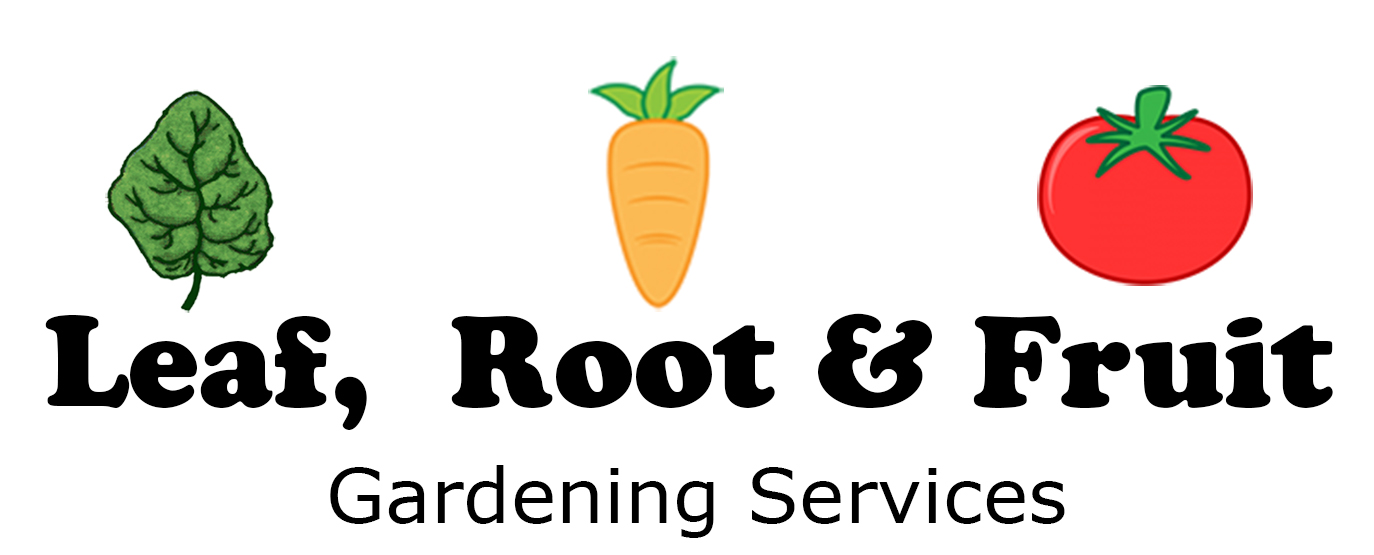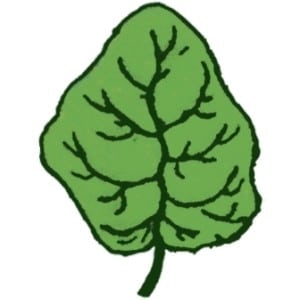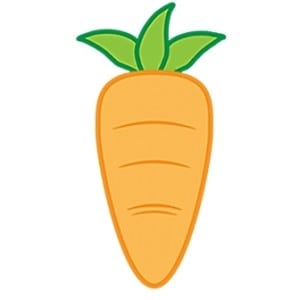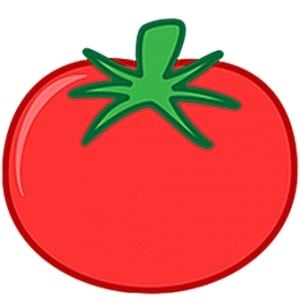Without correct advice, people new to edible gardening run the risk of failure and frustration. The most common reasons, are choosing the wrong plants to grow, or trying to grow them at the wrong time of the year. To help you choose which plants to grow, I have developed the Leaf, Root & Fruit Philosophy of Edible Gardening. It’s this philosophy that’s provided the name of the business, as well as the inspiration for the logo.
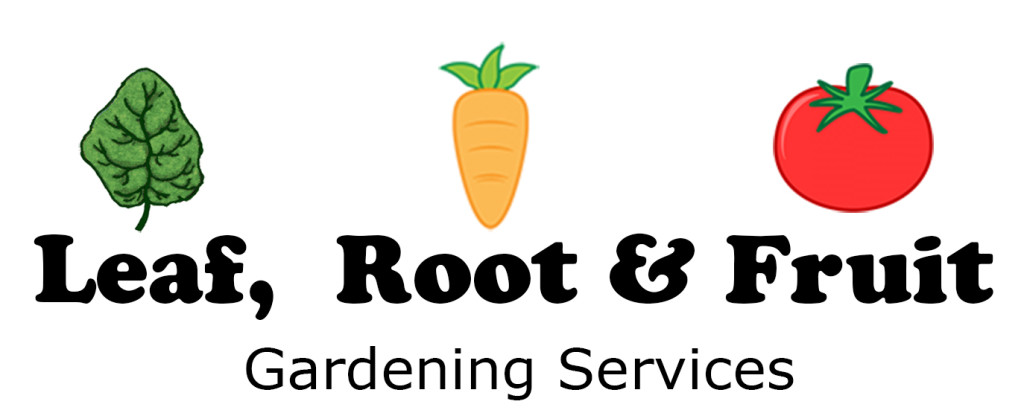
The Principle Behind My Edible Gardening Philosophy
The Leaf, Root & Fruit Philosophy of Edible Gardening is simple. Leaves are the easiest to grow, anyone can do it. Fruits are more of a commitment, they take a long time to come to fruition and have more complex growing requirements. Roots (plus bulbs and stems) are somewhere in the middle in terms of complexity and commitment.
Why? Think about the way a plant develops. First a seed germinates, puts down roots, sprouts leaves and grows bigger and bigger. Once the plant has reached full size, it flowers. If pollinated, the flower produces fruit. It takes time, sunlight, nutrients and water to grow plants to this stage. It takes even more time to condense nutrients and photosynthesized sugars into the fruit itself. Safely nurturing your plants through to fruiting stage and harvest, is a lot more difficult than sowing some leafy greens and picking them after only a few weeks. If you cannot provide optimum conditions for fruiting plants, then you will struggle grow a decent crop to justify the time, money, water and effort you spend on growing them. Too often I see people giving up on edible gardening in frustration, for this very reason. There are variations to the philosophy, such as radishes behaving more like leaf veggies and even strawberries with similar requirements to root crops. Beans, Peas and other legumes fall somewhere in between roots and fruits in terms of complexity and requirements.
I’ve tried to make it easy for you to remember the basics of the edible gardening philosophy by using a traffic light system within our logo.
The green spinach leaf represents the easy to grow leafy greens. The orange carrot represents the moderately complex roots. The red tomato represents fruits, which require the most commitment.
grow
Comparing Leaf, Root & Fruit Crops
| Difficulty Growing in Containers | Easy | Moderate | More complex |
| Examples | Lettuce, Rocket, Spinach, Silverbeet, Herbs, Broccoli. | Carrot, Turnip, Potato, Celery, Onion, Garlic, Beetroot. | Tomato, Pumpkin, Watermelon, Raspberry, Strawberry, Eggplant, Capsicum, Stone fruit (such as Apricot, Plum), Apple Citrus such as (Lime or Lemon). |
| Harvesting and Yields | Leaves can usually be picked from the plant as needed. Often picking leaves in this way encourages further growth. Leaves may be harvested over many weeks or even months. | Roots can be harvested over a semi-prolonged period. Harvesting them too early means that you will get smaller roots. Harvesting too late means the produce may be woody, or inedible. Gluts can be avoided by leaving root vegetables in the cool soil over winter and harvesting as needed. | Often all the fruit on the plant ripens at the same time. This causes a glut of food that needs to be preserved, or given away to avoid waste. |
| Nutrient requirements | Leaf vegetables can tolerate a wide range of soil nutrients. Soils high in nitrogen will cause the plant to grow vigorously. | Different roots have differing nutritional requirements. Soils high in Phosphorous promote root growth. | Fruiting plants often have specific nutritional requirements. These requirements vary throughout the growing cycle of the plant. For example high nitrogen content will cause the plant to grow very big, with masses of foliage, but without phosphorous and potassium, they will not produce much fruit. Getting this balance right is especially difficult in container gardens without regular application of specific liquid fertilizers. |
| Ongoing Maintenance requirements | Except for pest control, leafy greens usually require little or no maintenance. | Bar pest control, root vegetables usually require little or no maintenance. Garlic and onions must be carefully tended at maturity to avoid rotting of the bulbs. | Often fruiting plants require a lot of maintenance such as pest control, staking, pruning and netting. |
| Sunlight requirements | Whilst the leafy greens will certainly grow faster with plenty of sunlight. They have lower requirements than other edibles, so they can be grown in spaces that only receive direct sunlight for a short part of the day. | Moderate Requirements, so they should be grown in spaces that give them 4-6 hours of direct sunlight a day. However, many of these plants are grown over winter, when the days are shorter and less light is available | Plants that you are growing for fruit need a lot of direct, unfiltered sunlight, preferably 8+ hours a day. |
| Temperature requirements | Although they’ll grow slower in the cooler winter months, leafy greens can usually be grown all year round. In fact, the cooler weather can stop them bolting and going to seed. | Some root crops such as turnips and onions grow slowly, but prefer growing over the winter months, others such as potatoes are frost sensitive, so should only be planted once this danger has passed. | Many fruit crops are frost sensitive. Generally plants that are grown for their fruit and are only kept for one season (annual plants such as tomatoes, eggplant, pumpkin and watermelon) are frost sensitive and can only be grown in the warmer months. Perennial fruiting plants such as raspberries and stone fruit will generally go dormant in winter and only produce fruit seasonally. |
| Time to harvest | Most leafy greens will only take 6 to 8 weeks before you can start picking the leaves from the outside of the plant. You may be able to pick rocket leaves even sooner in warmer weather. | Root crops generally take a long time to get to harvest stage, usually because they are colder climate veggies that grow slowly over the winter. Carrots will take at least 3 months, Onion and Garlic may take up to 9 months to reach maturity. | Like root crops, fruit crops also take a long time to get to harvest stage. Some varieties of Tomatoes may be ripe three months after planting seedlings. Stone fruit and citrus trees can take years before they start to produce crops of any significance. |
| Watering requirements | Most edible plants require consistent and thorough watering, However, because of the much shorter time to harvest, generally leafy greens require less water to produce the same amount of edible biomass as fruit. | Roots also require consistent and thorough watering. Some varieties are susceptible to under or over-watering, which can cause defects in the produce, such as splitting in carrots. | Because they take longer to get to harvest, fruiting plants often require much more water to produce the same amount of biomass as leafy vegetables. Fruiting plants need regular and constant watering. Short, extreme periods of under or overwatering can lead to significant blemishes or other fruit quality issues, eg Blossom End Rot in tomatoes. |
Focus on Growing Leafy Greens
How often do you buy those pre-washed, chemical-laden, packaged “salads” of rocket, spinach or lettuce, only to have the bulk of the bag go mushy and fester in the bottom of the fridge? By concentrating on growing your own leaves, you’ll always have access to the freshest, chemical-free salad greens. These salad greens will all be ready for you to pick in the convenience of your own backyard, courtyard or balcony edible garden. That means less wasted food, less wasted money, less packaging and less transport related, environmental damage. In this scenario, everyone but the supermarket giant is a winner! Most importantly, the produce you grow yourself is also likely to taste far better than that sold in the supermarkets.
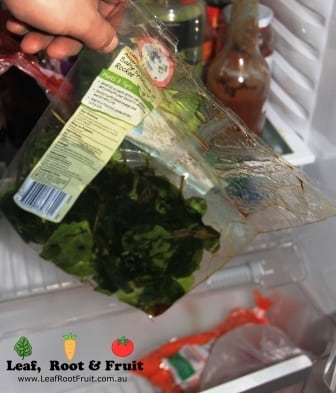
"If you grow it for the fruit or the root, you need full sun. If you grow it for the leaves, partial shade is all you need.
Gardening Saying Tweet
Edible Gardening in Containers
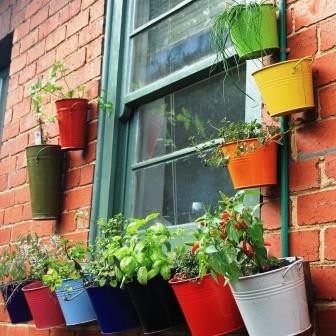
Here at Leaf, Root & Fruit we have enough experience to see that no two edible gardens are ever the same. Variations in location, soil type, rainfall, light availability, micro-climate and space mean that each garden has certain limitations. Edible gardens in containers and planter boxes are subject to all these variations. Factor in a small, finite space as another variable and the micro-climate you create needs extra attention. Whilst container-based edible gardens have the benefits of being able to be easily moved, and easily tended, it can also be difficult to maintain a steady supply of water and nutrients. When it comes to container gardening, some plants do better than others. Understanding the balance required to maximize your production from these micro-environments helps, even with very little knowledge of edible gardening, you can easily get started on growing your own food.
To make the most out of container and planter growing spaces, I recommend you devote much of it to cultivating leaves and herbs. You’ll enjoy them meal after meal in the quickest time frame and for very little effort. If you’ve got space left after planting your greens, then consider going for root crops like potatoes, carrots and beetroot. Still got space to spare? Then start planting fruits like tomatoes and capsicums.
Why not check out our blog post Top Ten Gardening Mistakes Made by Melbourne Based Gardeners and avoid making those ones as well.
Sign up to our newsletter for our monthly edible gardening wrap-up, including:
- A guide on what to plant in your garden in the upcoming month
- What’s happening in our garden and other gardens across Melbourne
- Upcoming gardening events
- Hints and tips on gardening
